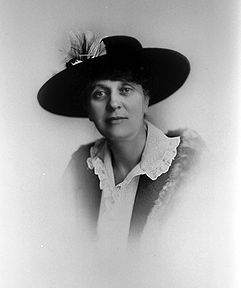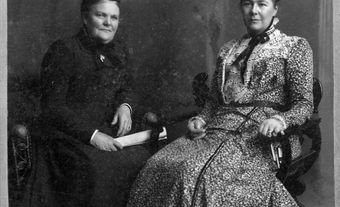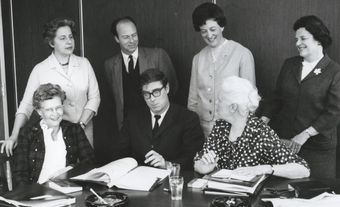Mary Irene Parlby (née Marryat), Alberta MLA (1921–35), women’s rights advocate, activist (born 9 January 1868 in London, UK; died 12 July 1965 in Red Deer, AB). Irene Parlby served as a Member of the Legislative Assembly (MLA) of Alberta for 14 years. She was the first woman in Alberta, and the second in the British Empire, to be appointed to a cabinet position. One of the Famous Five appellants in the Persons Case, Parlby was a compelling advocate for women’s rights. Known as the “Women’s Minister,” her career in activism and legislation was dedicated to improving the lives of rural women and children, such as with Alberta’s Dower Act in 1917. She was also a delegate to the League of Nations in 1930. However, she has also been criticized for her views on eugenics and for her support of Alberta’s Sexual Sterilization Act. She was named a Person of National Historic Significance in 1966 and an honorary senator in 2009.

Early Life
Irene Marryat was the eldest child of Colonel Ernest Lindsay Marryat. Born and partly raised in London, England, Irene moved to India when she was 13; her father was stationed there. Irene was educated at exclusive schools in Switzerland and Germany. Despite her father’s suggestion and support, she did not study medicine. Instead, she was interested in writing and theatre.
She travelled around Europe for a time. In 1896, she visited friends in Buffalo Lake, North-West Territories (later Alberta). Shortly after arriving, she met Walter Parlby, an Oxford graduate who had immigrated to Canada to join his brother, a farmer near the town of Alix, Alberta. Irene and Walter married in 1897.
After settling into her new home in Alix, Irene Parlby found that she enjoyed farm life on the Prairies. Rural Canada was considerably different from her background. In 1899, Parlby gave birth to her son, Humphrey.
United Farm Women of Alberta
Walter Parlby was involved with the United Farmers of Alberta (UFA). He was elected president of the Alix chapter in 1909. In 1913, Irene Parlby joined the Alix Country Women’s Club and was named its secretary. She said of her role there: “Little did I think as I accepted the position that I was taking the initial step that was going to plunge me into many years of public life, for which I had no ambition at all.”
One of Parlby’s first initiatives with the Women’s Club was to establish a local library. It was made possible by donations from readers of the London Spectator. They had seen Parlby’s advertisement for books in the paper.
In 1913, Irene Parlby organized the first women’s local of the UFA. She was elected president of the UFA Women’s Auxiliary in 1916. As president, Parlby was instrumental in transforming the auxiliary into an independent organization, the United Farm Women of Alberta (UFWA). In her new role, Parlby travelled the province. She called for better health care and social services, as well as better schools and libraries for rural families. (Parlby was president until 1920.)
In 1916, Parlby presented a paper at a joint UFA/UFWA convention in Calgary titled “Women’s Place in the Nation.” In it, she argued that women should insert themselves in all areas of society.
Along with leading feminist activists in Alberta — Louise McKinney, Henrietta Edwards and Emily Murphy among them — Irene Parlby helped push the Dower Act through the Alberta legislature in 1917. (See also Dower.) The act was a vital piece of legislation that protected married women’s property rights. (See also Irene Parlby and the United Farmers of Alberta.)

The Board of Directors of the United Farmers of Alberta in 1919. Irene Parlby sits in the front row, third from the right.
“Women’s Minister”
The UFA transformed into a political party in 1921. It sought to regulate the grain trade and opposed the privatization of transportation while also highlighting other concerns of the western province.
Irene Parlby was nominated as a UFA candidate in the Lacombe district. She reportedly only agreed to run because she thought the UFA had little chance of success. Parlby described the ensuing campaign as “nasty.” She said that the “only thing which seemed to concern my opponents was that I am a woman — and worse, an Englishwoman who, although I came to Western Canada when it was still an undeveloped wilderness, could not possibly know anything about it!”
On 18 July 1921, the UFA won a majority in the Alberta legislature, and Parlby was elected MLA for her district. Premier Herbert Greenfield appointed Irene Parlby to cabinet, making her the second woman in the British Empire to hold such a position. (The first was Mary Ellen Smith, elected to the British Columbia legislature a few months earlier.) Parlby was named Minister without Portfolio, with special responsibility for advising the government on issues of particular concern to women and children. However, she was without a mandate or budget to take any action. Popularly known as the “Women’s Minister,” Parlby was particularly active on issues related to health care, improved wages for working women and married women’s property rights.
Lacombe constituents returned Parlby to office in 1926 and again in 1930. Over her 14 years in the Alberta Legislature, Parlby’s persistence and patience served her well. As she once said, “evolution cannot be brought about by the use of dynamite.”
Women’s Rights Legislation
As “Women’s Minister,” Irene Parlby sponsored successful legislation for a minimum wage for women, mothers’ allowance grants, and improvements to the Dower Act and the Official Guardian Act, among others. Parlby advocated for mobile dental and medical services as well as municipal hospitals.
Not all of Parlby’s bills were successful, however. In 1925, she introduced the Community of Property Bill. It proposed that all property brought into a marriage by a woman, or acquired as an inheritance or gift, remain in her name. It also stipulated that all other property gained during the marriage would remain community property. The bill was considered too radical and failed. (See also Property Law.)
Parlby had a positive reputation in politics. Nearly 20 laws concerning the welfare of women and children were passed during her time in public office. Some called Parlby the “Minister of Cooperation.”

The first United Farmers of Alberta legislative caucus in summer 1921. This was the meeting at which Herbert Greenfield was selected as Premier. On the right is Richard Reid, who would later serve as Premier himself. On the left, in the white hat, is Irene Parlby, Alberta's first female cabinet minister.
Persons Case
In August 1927, Emily Murphy, Canada’s first woman judge, invited Henrietta Edwards, Irene Parlby, Louise McKinney and Nellie McClung to a meeting at her Edmonton home. Murphy had carefully drafted a petition to put before the Supreme Court of Canada regarding the interpretation of the word persons in the British North America Act (now called the Constitution Act, 1867). At the time, women were not included in the definition of persons under the Constitution.
Murphy and the others signed the petition. Edwards’s signature appeared first; thus, the case was titled Edwards v. Attorney General of Canada. The petition asked the Supreme Court whether the word persons in Section 24 of the British North America Act, 1867 included women. If it considered women to be persons, the Constitution would allow for a woman to be appointed to the Senate.
Handing down the judgment on 24 April 1928, the Supreme Court denied the petition. The women — first called the “Alberta Five” and later the “Famous Five” — took their request to the Judicial Committee of the Privy Council in England (Canada’s highest court of appeal until 1949).
On 18 October 1929, after much deliberation, the Privy Council reversed the decision of the Supreme Court. It concluded that “the word ‘persons’ in sec. 24 does include women, and that women are eligible to be summoned to and become members of the Senate of Canada.” Lord Sankey, who delivered the judgement on behalf of the Privy Council in what became known as the Persons Case, also remarked that the “exclusion of women from all public offices is a relic of days more barbarous than ours […] and to those who ask why the word [persons] should include females, the obvious answer is why should it not.”
Eugenics
Like other members of the Famous Five, Irene Parlby has been criticized as being elitist and racist, and for supporting the eugenics movement. Eugenics was a pseudoscience that subscribed to the idea that the human population could be improved by controlling reproduction. Many influential Canadians, including J. S. Woodsworth, Dr. Clarence Hincks and Tommy Douglas, supported eugenic ideas in the early 1900s. (See also Tommy Douglas and Eugenics.) They promoted both “positive” eugenics (promoting the breeding of “fit” members of society) and “negative” eugenics (discouraging procreation by those considered “unfit”). Eugenicists argued that “mental defectives” and the “feeble-minded” were prone to alcoholism, promiscuity, mental illness, delinquency and criminal behaviour, and therefore posed a threat to the moral fabric of the community. These concerns led to increasing support for eugenic legislation, including the sterilization of “defectives.”
Parlby supported the passing of eugenics legislation, titled the Sexual Sterilization Act, while she was an Alberta cabinet minister. In a 1924 speech to members of the United Farm Women of Alberta, Parlby posed a question about the standard farming practice of culling the herd to breed only the best animals, “and yet when it comes to the human race we allow the mating of the most diseased and imperfect both mentally and physically?”
Parlby and others believed the sterilization procedures would prevent further problems and so passed the Sexual Sterilization Act. The legislation was enacted in 1928 and repealed in 1972. During that time, thousands of people deemed “psychotic” or “mentally deficient” underwent forced sterilization. A disproportionate number of them were Indigenous women. (See also Sterilization of Indigenous Women in Canada.)
League of Nations
In 1930, Prime Minister R.B. Bennett appointed Irene Parlby one of three Canadian delegates to the League of Nations meeting in Geneva, Switzerland. The League of Nations was instituted in 1919 after the First World War, with the goal of preventing war through negotiation, disarmament and collective security. The League was replaced by the United Nations after the Second World War.

Later Life
As elections approached in 1935, Irene Parlby declined to run for a fourth term in office. She settled back into the comfort of her home. She took care of family and continued to champion the betterment of women. In the same year, the University of Alberta awarded her an honorary Doctor of Laws for the many years she served on its board of governors. Parlby was the first woman to receive an honorary doctorate from the University of Alberta.
Legacy
The Government of Canada recognized Irene Parlby as a Person of National Historic Significance in 1966. This was based on her role in the Persons Case, but also for her work as a member of the Legislative Assembly of Alberta and for her distinguished service in the fields of “education, social welfare, and legislative reform.” In October 2009, 80 years after the Persons Case, the Senate of Canada voted to recognize the Famous Five as honorary senators. It was the first time the Senate had bestowed such a distinction.
See also National Council of Women of Canada; Women’s Movements in Canada; Status of Women; Royal Commission on the Status of Women in Canada; Council on the Status of Women; Women and the Law; Women’s Organizations.

 Share on Facebook
Share on Facebook Share on X
Share on X Share by Email
Share by Email Share on Google Classroom
Share on Google Classroom




